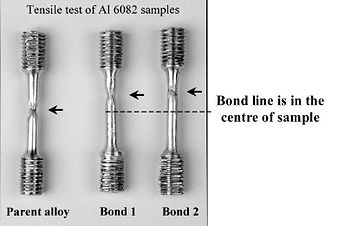Diffusion Bonding Aluminum Alloys


Gallium-assisted diffusion bonding of aluminium alloys
Tensile samples failed away from bond-lines (right)
Bent and twisted samples show no sign of failure at their joints (left)
Aluminum - perhaps most difficult material to diffusion bond
Source: Shirzadi et al. SURFACE AND INTERFACE ANALYSIS 2001; 31: 609–618
The presence of stable oxide films on the faying surfaces of some materials is one of the major barriers in achieving high- strength and reliable diffusion bonds. Hence, aluminium- based alloys and composites are particularly difficult to diffusion bond. The surface oxides on such materials are physically very adherent, chemically stable and insoluble in the aluminium matrix at all temperatures, and so prevent full metal-to-metal contact from being established at the joint interface. asdfa
During the last few decades, different approaches have been developed to circumvent the oxide problem when solid-state diffusion bonding. Most of these approaches are based on either physical disruption of the oxide film (by imposing plastic deformation during bonding) or chemical decomposition of the oxide using reactive elements (e.g. using Mg or Li as alloying elements within the base alloy or interlayer). Despite some progress in improving bond integrity using these approaches, the solid-state diffusion bonding of aluminium alloys remains unsuccessful and interest in further research in this field seems to have declined substantially in the recent years. Non-conventional approaches, such as removing the oxide layer in a vacuum before deposition of an interlayer or bonding at a temperature above solidus temperature, have limited application because they require extreme bonding conditions and/or complicated equipment.
Transient liquid-phase diffusion bonding is a promising method that has the potential to overcome the oxide problem. The formation of a liquid phase can result in fragmentation of the continuous oxide surface layers and therefore bond strengths can be improved substantially. However, following isothermal solidification, which is inherent in this process, fairly flat interfaces containing oxide particles and impurities form and such interfaces naturally have detrimental effects on the resulting bond strengths. Thus, regardless of the type of bonding process, whether solid state or conventional TLP, the bond lines of materials with stable oxide films will contain impurities and discontinuities that inhibit the formation of ideal and complete metallic bonds.
Temperature-gradient TLP diffusion bonding is a new approach capable of producing bond lines with various morphologies (e.g. sinusoidal to fully dendritic) by controlling the temperature profile across the liquid phase during bonding. Although oxide and impurities remain at the interfaces when using this new method, bond strengths and reliability increase dramatically due to the higher metal-to-metal contact along the non-planar interfaces compared with the planar interfaces associated with either conventional TLP or solid-state diffusion bonding processes. Using this method, reliable bonds with shear strength as high as those of parent materials have been produced in aluminium alloys. It is likely that this new method will be of benefit when joining other materials with stable oxide films.
